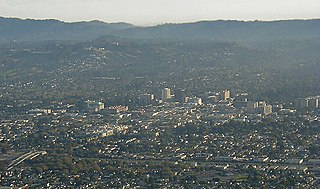
San Mateo is a city in San Mateo County, California, United States, on the San Francisco Peninsula. About 20 miles (32 km) south of San Francisco, the city borders Burlingame to the north, Hillsborough to the west, San Francisco Bay and Foster City to the east and Belmont to the south. The population was 105,661 at the 2020 census.

The Asian Art Museum of San Francisco – Chong-Moon Lee Center for Asian Art and Culture is a museum in San Francisco, California that specializes in Asian art. It was founded by Olympian Avery Brundage in the 1960s and has more than 18,000 works of art in its permanent collection, some as much as 6,000 years old. Its logo is an upside down letter A, which also looks like a letter V with a line through it.

Golden Gate Park is an urban park between the Richmond and Sunset districts of San Francisco, United States. It is the largest park in the city, containing 1,017 acres (412 ha), and the third-most visited urban park in the United States, with an estimated 24 million visitors annually.
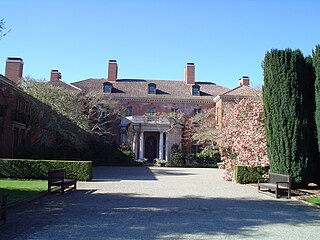
Filoli, also known as the Bourn-Roth Estate, is a country house set in 16 acres (6.5 ha) of formal gardens surrounded by a 654-acre (265 ha) estate, located in Woodside, California, about 25 miles (40 km) south of San Francisco, at the southern end of Crystal Springs Reservoir, on the eastern slope of the Santa Cruz Mountains. Now owned by the National Trust for Historic Preservation, Filoli is open to the public. The site is both a California Historical Landmark and listed on the National Register of Historic Places.

Hakone Gardens is an 18-acre (7.3 ha) traditional Japanese garden in Saratoga, California, United States. A recipient of the Save America's Treasures Award by the National Trust for Historic Preservation, it is recognized as one of the oldest Japanese-style residential gardens in the Western Hemisphere. Notable features include a bamboo garden, a Zen garden, a strolling garden, tea houses, and the Cultural Exchange Center, which is an authentic reproduction of a 19th-century Kyoto tea merchant's house and shop.
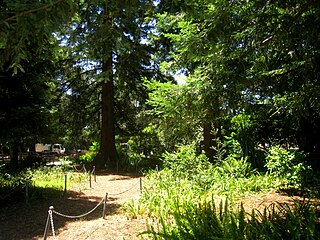
The San Mateo Arboretum is an arboretum in San Mateo, California containing old stands of pine, oak, cedar, and redwood planted over 100 years ago on the William Kohl property by John McLaren. The Arboretum is located in San Mateo's Central Park, which also houses the San Mateo Arboretum Society near the Kohl Pump House area of the park.
Makoto Hagiwara was a Japanese-born American landscape designer responsible for the maintenance and expansion of the Japanese Tea Garden at Golden Gate Park in San Francisco, California, from 1895 until his death in 1925. Hagiwara is often credited with the invention of the fortune cookie in California.

A teahouse or tearoom is an establishment which primarily serves tea and other light refreshments. A tea room may be a room set aside in a hotel, especially for serving afternoon tea, or may be an establishment that only serves cream teas. Although the function of a tearoom may vary according to the circumstance or country, teahouses often serve as centers of social interaction, like coffeehouses.

The Japanese Tea Garden in San Francisco, California, is a popular feature of Golden Gate Park, originally built as part of a sprawling World's Fair, the California Midwinter International Exposition of 1894. Though many of its attractions are still a part of the garden today, there have been changes throughout the history of the garden that have shaped it into what it is today.

John Hays McLaren (1846–1943) was a Scottish-born American horticulturalist. For 56 years he served as superintendent of the Golden Gate Park in San Francisco, California.
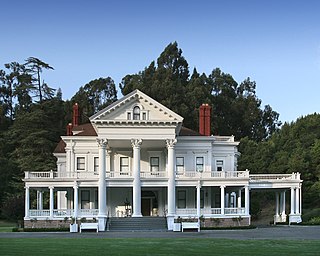
The Dunsmuir House and Gardens is located in Oakland, California on a 50-acre (200,000 m2) site. The Dunsmuir House has a neoclassical-revival architectural style and is listed in the U.S. National Register of Historic Places. It is now used primarily for weddings, receptions, business gatherings and historical reenactment events.
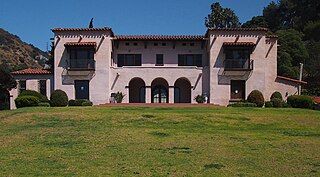
The Wattles Estate, originally known as Jualita, is a historic house and park in the Hollywood area of Los Angeles, California, United States. It was built in 1907 by wealthy Omaha, Nebraska, banker Gurdon Wattles as a winter home. Next to the Wattles Mansion are Wattles Park and Wattles Gardens, now administered by the City of Los Angeles and open to the public.
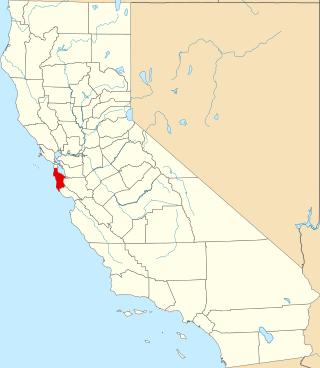
This is a list of the National Register of Historic Places listings in San Mateo County, California.

Henry Pike Bowie was an American lawyer, artist, author, Japanologist, and diplomat.
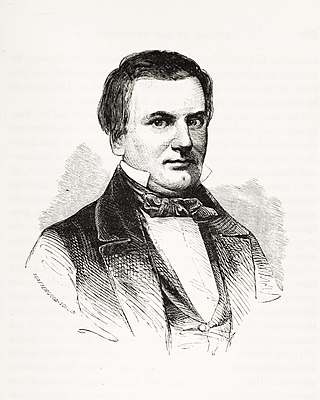
William Davis Merry Howard (1818–1856), known in Spanish as Don Guillermo Howard, was an American businessman, known as one of San Francisco's wealthiest men during the California Gold Rush.

The Japanese Friendship Garden, also known as Sankei-en is a twelve-acre Japanese garden located within Balboa Park in San Diego, California. It is an expression of friendship between San Diego and its Japanese sister city Yokohama that binds the two cultures to create a unique experience for visitors from all over the world; over 240,000 people from across the United States and the world visit the garden annually. Representing a new concept in the development of a Japanese garden outside Japan, the Japanese Friendship Garden is designed to present an atmosphere of elegant simplicity (shibui) and quiet beauty. The garden's naturalistic design is guided by the original principles/techniques of the Japanese garden while incorporating elements of the regional San Diego landscape and climate; in terms of features, the garden is well known for its unique placement, sukiya-style buildings, koi ponds, and landscape exhibits. The Japanese Friendship Garden also hosts many local educational programs, activities, festivals, and horticultural classes that focus on the relationship between nature and Japanese culture.

Central Park is the first public park in San Mateo, California, a 16.5-acre (7 ha) urban park bounded by El Camino Real, 5th Avenue, Laurel Avenue and 9th Avenue. It was established via a 1922 bond measure of US$80,000 to purchase the land originally owned by Charles B. Polhemus, and currently hosts a baseball field, tennis courts, sculptures, playground, Japanese tea garden, recreation center, miniature train, rose garden and the San Mateo Arboretum.

Jean Harold (Harald) Edward de Saint Cyr was the alias of John Henry Edward Thompson of Waco, Texas. He was a fortune-hunting playboy who married three older wealthy widows. His first wife Caroline Redfield was 34 years older than he was. After her husband Henry Redfield died in 1907, she began to rely on Bob Swem, a mutual acquaintance of her husband's. Swem made himself indispensable to the widow Redfield, and was believed to be a fortune hunter. The two of them were in turn befriended by Saint Cyr, reportedly a hotel clerk who convinced both Swem and Redfield that he was affiliated with the entertainment business. When Saint Cyr became Caroline's live-in companion and escort, Swen was nudged out of the picture. Saint Cyr and Caroline married in 1909, and upon her January 1915 death, he inherited the bulk of her $1,000,000 estate.

The Willard Griffin House and Carriage House is a historic mansion and carriage house located in Los Altos, California. The estate, constructed in 1901, features a three-story main house designed in the American Craftsman style. The Willard Griffin House and Carriage House was placed on the National Register of Historic Places on April 13, 1977. Today, the house and carriage house are located at the lower section of the Foothill College campus.



















